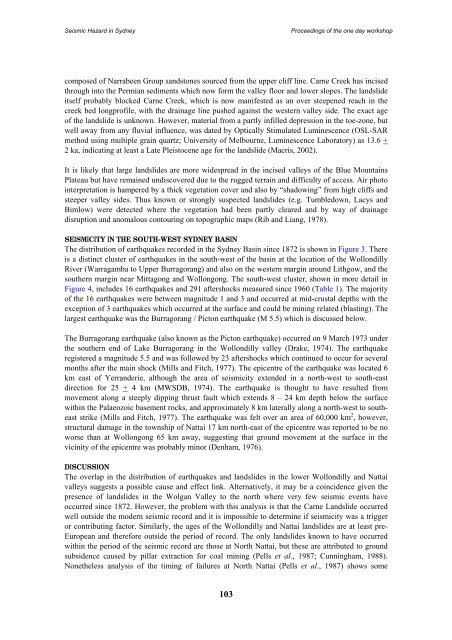Landslides in the Sydney Basin - Geoscience Australia
Landslides in the Sydney Basin - Geoscience Australia
Landslides in the Sydney Basin - Geoscience Australia
- No tags were found...
You also want an ePaper? Increase the reach of your titles
YUMPU automatically turns print PDFs into web optimized ePapers that Google loves.
Seismic Hazard <strong>in</strong> <strong>Sydney</strong>Proceed<strong>in</strong>gs of <strong>the</strong> one day workshopcomposed of Narrabeen Group sandstones sourced from <strong>the</strong> upper cliff l<strong>in</strong>e. Carne Creek has <strong>in</strong>cisedthrough <strong>in</strong>to <strong>the</strong> Permian sediments which now form <strong>the</strong> valley floor and lower slopes. The landslideitself probably blocked Carne Creek, which is now manifested as an over steepened reach <strong>in</strong> <strong>the</strong>creek bed longprofile, with <strong>the</strong> dra<strong>in</strong>age l<strong>in</strong>e pushed aga<strong>in</strong>st <strong>the</strong> western valley side. The exact ageof <strong>the</strong> landslide is unknown. However, material from a partly <strong>in</strong>filled depression <strong>in</strong> <strong>the</strong> toe-zone, butwell away from any fluvial <strong>in</strong>fluence, was dated by Optically Stimulated Lum<strong>in</strong>escence (OSL-SARmethod us<strong>in</strong>g multiple gra<strong>in</strong> quartz; University of Melbourne, Lum<strong>in</strong>escence Laboratory) as 13.6 +2 ka, <strong>in</strong>dicat<strong>in</strong>g at least a Late Pleistocene age for <strong>the</strong> landslide (Macris, 2002).It is likely that large landslides are more widespread <strong>in</strong> <strong>the</strong> <strong>in</strong>cised valleys of <strong>the</strong> Blue Mounta<strong>in</strong>sPlateau but have rema<strong>in</strong>ed undiscovered due to <strong>the</strong> rugged terra<strong>in</strong> and difficulty of access. Air photo<strong>in</strong>terpretation is hampered by a thick vegetation cover and also by “shadow<strong>in</strong>g” from high cliffs andsteeper valley sides. Thus known or strongly suspected landslides (e.g. Tumbledown, Lacys andBimlow) were detected where <strong>the</strong> vegetation had been partly cleared and by way of dra<strong>in</strong>agedisruption and anomalous contour<strong>in</strong>g on topographic maps (Rib and Liang, 1978).SEISMICITY IN THE SOUTH-WEST SYDNEY BASINThe distribution of earthquakes recorded <strong>in</strong> <strong>the</strong> <strong>Sydney</strong> Bas<strong>in</strong> s<strong>in</strong>ce 1872 is shown <strong>in</strong> Figure 3. Thereis a dist<strong>in</strong>ct cluster of earthquakes <strong>in</strong> <strong>the</strong> south-west of <strong>the</strong> bas<strong>in</strong> at <strong>the</strong> location of <strong>the</strong> WollondillyRiver (Warragamba to Upper Burragorang) and also on <strong>the</strong> western marg<strong>in</strong> around Lithgow, and <strong>the</strong>sou<strong>the</strong>rn marg<strong>in</strong> near Mittagong and Wollongong. The south-west cluster, shown <strong>in</strong> more detail <strong>in</strong>Figure 4, <strong>in</strong>cludes 16 earthquakes and 291 aftershocks measured s<strong>in</strong>ce 1960 (Table 1). The majorityof <strong>the</strong> 16 earthquakes were between magnitude 1 and 3 and occurred at mid-crustal depths with <strong>the</strong>exception of 3 earthquakes which occurred at <strong>the</strong> surface and could be m<strong>in</strong><strong>in</strong>g related (blast<strong>in</strong>g). Thelargest earthquake was <strong>the</strong> Burragorang / Picton earthquake (M 5.5) which is discussed below.The Burragorang earthquake (also known as <strong>the</strong> Picton earthquake) occurred on 9 March 1973 under<strong>the</strong> sou<strong>the</strong>rn end of Lake Burragorang <strong>in</strong> <strong>the</strong> Wollondilly valley (Drake, 1974). The earthquakeregistered a magnitude 5.5 and was followed by 23 aftershocks which cont<strong>in</strong>ued to occur for severalmonths after <strong>the</strong> ma<strong>in</strong> shock (Mills and Fitch, 1977). The epicentre of <strong>the</strong> earthquake was located 6km east of Yerranderie, although <strong>the</strong> area of seismicity extended <strong>in</strong> a north-west to south-eastdirection for 25 + 4 km (MWSDB, 1974). The earthquake is thought to have resulted frommovement along a steeply dipp<strong>in</strong>g thrust fault which extends 8 – 24 km depth below <strong>the</strong> surfacewith<strong>in</strong> <strong>the</strong> Palaeozoic basement rocks, and approximately 8 km laterally along a north-west to sou<strong>the</strong>aststrike (Mills and Fitch, 1977). The earthquake was felt over an area of 60,000 km 2 , however,structural damage <strong>in</strong> <strong>the</strong> township of Nattai 17 km north-east of <strong>the</strong> epicentre was reported to be noworse than at Wollongong 65 km away, suggest<strong>in</strong>g that ground movement at <strong>the</strong> surface <strong>in</strong> <strong>the</strong>vic<strong>in</strong>ity of <strong>the</strong> epicentre was probably m<strong>in</strong>or (Denham, 1976).DISCUSSIONThe overlap <strong>in</strong> <strong>the</strong> distribution of earthquakes and landslides <strong>in</strong> <strong>the</strong> lower Wollondilly and Nattaivalleys suggests a possible cause and effect l<strong>in</strong>k. Alternatively, it may be a co<strong>in</strong>cidence given <strong>the</strong>presence of landslides <strong>in</strong> <strong>the</strong> Wolgan Valley to <strong>the</strong> north where very few seismic events haveoccurred s<strong>in</strong>ce 1872. However, <strong>the</strong> problem with this analysis is that <strong>the</strong> Carne Landslide occurredwell outside <strong>the</strong> modern seismic record and it is impossible to determ<strong>in</strong>e if seismicity was a triggeror contribut<strong>in</strong>g factor. Similarly, <strong>the</strong> ages of <strong>the</strong> Wollondilly and Nattai landslides are at least pre-European and <strong>the</strong>refore outside <strong>the</strong> period of record. The only landslides known to have occurredwith<strong>in</strong> <strong>the</strong> period of <strong>the</strong> seismic record are those at North Nattai, but <strong>the</strong>se are attributed to groundsubsidence caused by pillar extraction for coal m<strong>in</strong><strong>in</strong>g (Pells et al., 1987; Cunn<strong>in</strong>gham, 1988).None<strong>the</strong>less analysis of <strong>the</strong> tim<strong>in</strong>g of failures at North Nattai (Pells et al., 1987) shows some103
















